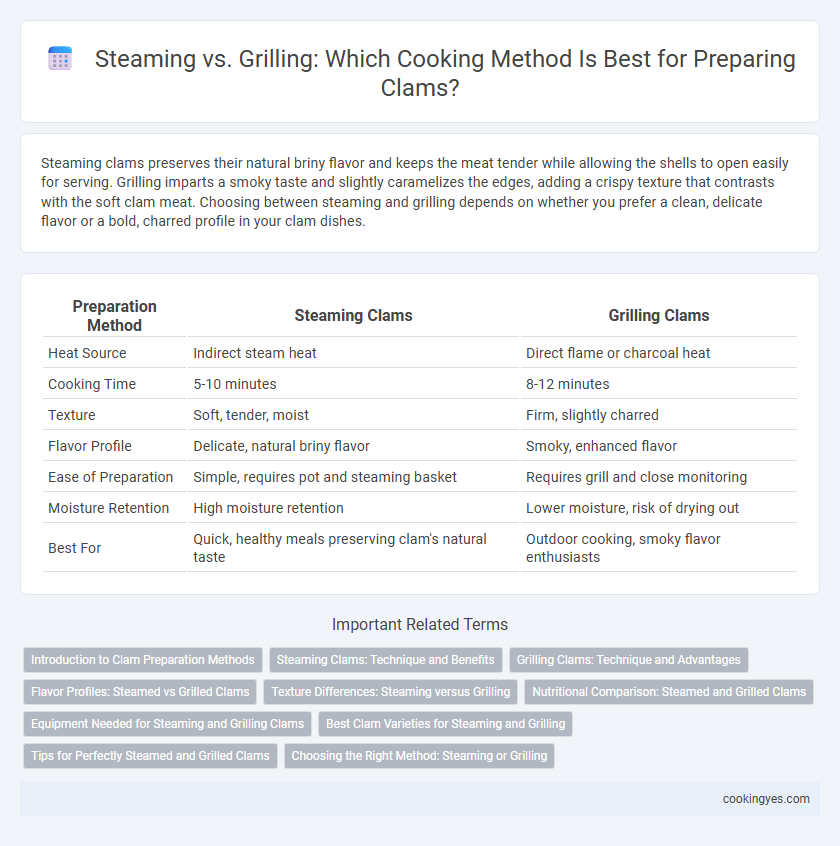Steaming clams preserves their natural briny flavor and keeps the meat tender while allowing the shells to open easily for serving. Grilling imparts a smoky taste and slightly caramelizes the edges, adding a crispy texture that contrasts with the soft clam meat. Choosing between steaming and grilling depends on whether you prefer a clean, delicate flavor or a bold, charred profile in your clam dishes.
Table of Comparison
| Preparation Method | Steaming Clams | Grilling Clams |
|---|---|---|
| Heat Source | Indirect steam heat | Direct flame or charcoal heat |
| Cooking Time | 5-10 minutes | 8-12 minutes |
| Texture | Soft, tender, moist | Firm, slightly charred |
| Flavor Profile | Delicate, natural briny flavor | Smoky, enhanced flavor |
| Ease of Preparation | Simple, requires pot and steaming basket | Requires grill and close monitoring |
| Moisture Retention | High moisture retention | Lower moisture, risk of drying out |
| Best For | Quick, healthy meals preserving clam's natural taste | Outdoor cooking, smoky flavor enthusiasts |
Introduction to Clam Preparation Methods
Steaming clams preserves their natural briny flavor and tenderness by cooking them gently with steam, often infused with aromatic herbs and wine to enhance taste. Grilling clams imparts a smoky char and a firmer texture, making them ideal for those who enjoy a slightly crisp exterior and robust flavor. Both methods require fresh, live clams and careful timing to avoid overcooking, ensuring a delicious and safe seafood experience.
Steaming Clams: Technique and Benefits
Steaming clams preserves their natural briny flavor while ensuring even cooking and tender texture. The technique involves heating a small amount of liquid, such as water, wine, or broth, in a covered pot until it produces steam that gently opens the clam shells. Steamed clams retain more nutrients compared to grilling, making this method a healthy option for seafood preparation.
Grilling Clams: Technique and Advantages
Grilling clams involves placing them directly over medium-high heat until they open, typically within 5 to 10 minutes, which enhances their natural briny flavor through caramelization. This method imparts a smoky taste and a slightly charred texture that steaming cannot achieve, appealing to those who prefer a more robust flavor profile. Grilling also allows excess moisture to evaporate, concentrating the clam's sweetness and making it a preferred choice for outdoor cooking and rustic presentations.
Flavor Profiles: Steamed vs Grilled Clams
Steamed clams preserve a tender texture and release a delicate, briny flavor that highlights their natural sweetness, often enhanced by aromatics such as garlic, white wine, and herbs. Grilling clams imparts a smoky, charred essence, intensifying their oceanic taste and creating a slightly firmer chew with caramelized notes. Both methods offer unique flavor profiles, with steaming emphasizing freshness and grilling adding robust, savory complexity.
Texture Differences: Steaming versus Grilling
Steaming clams preserves their tender, juicy texture by gently cooking them in moist heat, resulting in a soft and succulent bite. Grilling imparts a smoky, charred flavor that firms up the clam meat, creating a slightly chewy texture with crisp edges. The choice between steaming and grilling clams significantly influences the final mouthfeel and flavor profile, catering to different texture preferences.
Nutritional Comparison: Steamed and Grilled Clams
Steamed clams retain more moisture and preserve higher levels of water-soluble vitamins such as B12 and vitamin C, while grilling can enhance flavor through caramelization but may cause slight nutrient loss due to higher heat exposure. Grilled clams typically contain a similar protein content but can have reduced omega-3 fatty acids compared to steamed versions. Both methods offer low-calorie, mineral-rich options, but steaming better maintains clam's antioxidant properties and delicate nutrients.
Equipment Needed for Steaming and Grilling Clams
Steaming clams requires a large pot with a tight-fitting lid and a steaming basket or rack to keep clams elevated above the boiling water. Grilling clams involves using a preheated grill with cooking grates and optional tools like tongs and a grill brush to manage the heat and clean the surface. Both methods demand precise temperature control equipment to ensure clams open properly without overcooking.
Best Clam Varieties for Steaming and Grilling
Soft-shell clams and littleneck clams are ideal for steaming due to their tender texture and ability to retain a juicy flavor during the gentle cooking process. For grilling, quahog clams and razor clams stand out, as their firmer meat holds up well to high heat and develops a smoky, charred taste. Selecting the right clam variety enhances the final dish by optimizing texture and maximizing the natural briny essence unique to each preparation method.
Tips for Perfectly Steamed and Grilled Clams
To achieve perfectly steamed clams, use high-quality fresh clams and steam them over boiling water with aromatic herbs for about 5-7 minutes until shells open fully. When grilling, place clams directly on a preheated grill at medium-high heat, turning occasionally until shells open and juices are visible, typically 6-8 minutes. Always discard any clams that do not open after cooking to ensure safety and optimal texture.
Choosing the Right Method: Steaming or Grilling
Steaming clams preserves their natural briny flavor and ensures even cooking by gently opening the shells without drying the meat. Grilling imparts a smoky, charred taste and slightly firmer texture, ideal for enhancing the clam's savory profile with added spices or marinades. Selecting steaming or grilling depends on preferred flavor intensity and texture, with steaming favored for delicate freshness and grilling chosen for robust, smoky complexity.
Steaming vs Grilling for preparation Infographic

 cookingyes.com
cookingyes.com